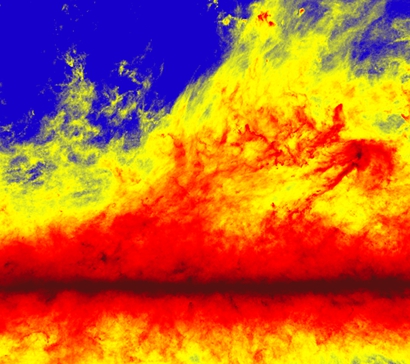One of my favorite things about astronomy is that it opens our eyes to things those eyes literally cannot see.
I have been to dark sites countless times and gazed up at the Milky Way; that dim and fuzzy path of light that represents the combined glow of billions of stars, gas clouds, and dust. To my eyes, it’s bright enough to see some details, and it’s lovely… but what we see is a facade, the barest skin draped thinly over depth and grandeur we can hardly perceive.
That is, until we look at our galaxy with new eyes: ones tuned to the far, far infrared. Then we see magnificence on a scale so breathtaking we can hardly comprehend it. Behold!
That is what lurks beneath the dim view our eyes collect! It’s what the European Space Agency’s Planck observatory sees when it looks at the Milky Way.
Wow! This image is a whopping 55 square degrees of sky – 280 times the area of the full Moon on the sky – centered near the constellation of Aquila the Eagle. The resolution of the data is about 5 arcminutes, meaning objects as small as 1/6th the size of the Moon on the sky can be distinguished; that’s very high-res for images in this region of the electromagnetic spectrum. And as an astronomer who is pretty familiar with the night sky, I have to say it’s very weird to see an image like this and have almost no idea what’s in it.
I mean, I know a lot of what I’m seeing in general, but specific objects are totally impossible to identify. That’s because this image is hugely removed from visible light. It’s a three-color image composed of separate shots in the wavelengths (think of them as colors) of 100, 350, and 540 microns. For comparison, the longest wavelength of light our eyes can see is about 0.7 microns or so; these Planck images are therefore way the heck and gone in the infrared.
What we’re seeing is very cold dust, and by very cold I mean very cold: much of it is a frigid 12 Celsius above absolute zero. In Fahrenheit, that’s -438°. Yes, four hundred thirty eight degrees below zero.
This represents dust far away from the warming light of stars, dust that is sitting in deep space, radiating away feebly in the far infrared. Mapping this dust tells us much about it, like how stars make dust and fling it into space, and how the dust behaves when it’s out there.
See that bright line right down the middle? That’s the dust located in the disk of the Milky Way galaxy itself. Our galaxy is a flat disk 100,000 light years across, but maybe only 1% of that in thickness. We’re located inside that disk, so that when we look in that direction we see it projected as a line across the sky. That’s where most of the gas and stars in the galaxy are located, so that’s where most of the dust is as well.
But I’m fascinated by the structure of the dust above the galactic plane. There are swoops and swirls, filaments and ribbons. I’m drawn to the long thin line on the right that must be dozens or hundreds of light years long; it appears to end in a swirl of dust. What the heck could be causing that? I’m not sure. There’s so much going on here that it’ll be some time before astronomers can sort it all out.
 One thing I want to point out is the one component of that image taken at 350 microns, seen here on the left. This is extremely cold dust, and as a major geek I can’t help wonder if the structure seen here was diverted by Malcolm McDowell to swing past Veridian III.
One thing I want to point out is the one component of that image taken at 350 microns, seen here on the left. This is extremely cold dust, and as a major geek I can’t help wonder if the structure seen here was diverted by Malcolm McDowell to swing past Veridian III.
And if you’re looking for irony, you’ve found it: Planck is designed to investigate the Cosmic Microwave Background, the faint glow leftover from the Big Bang. As far as Planck is concerned, the Milky Way is a foreground object blocking the view! It has to map our local space very carefully so that emission can be removed from the actual target data, and reveal what the far more distant background Universe can tell us.
It’s true in astronomy as well as so many other aspects of life: what’s signal to one is noise to another.
Credit: ESA and the HFI Consortium